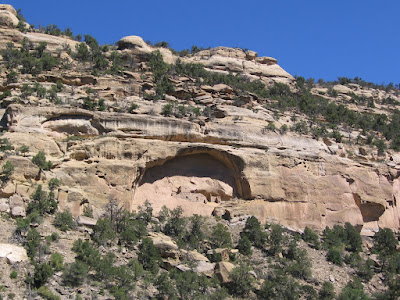The Wetherill Mesa area of Mesa Verde National Park is usually only open in the summer months between Memorial Day and Labor Day, but on September 19, 2010 the tram road was opened for a special day of hiking and biking. This special day is among the new visitor activities in 2010 that have also included three new back country hikes.
The main attractions on Wetherill Mesa are the self guided tours at Step House and the four mesa top sites of the Badger House Community Trail along with the guided tour at the very large alcove ruins site Long House.
The tram usually provides transportation to these sites and the overlook to Kodak House and the trailhead for the Nordenskiold No. 16 Trail. Park Rangers were available to provide information and support for visitors biking and hiking the normally closed paved trail.
The tram usually provides transportation to these sites and the overlook to Kodak House and the trailhead for the Nordenskiold No. 16 Trail. Park Rangers were available to provide information and support for visitors biking and hiking the normally closed paved trail.
One of the highlights of this special day was that the trail to Long House was open for leisurely visits, with rangers stationed at the site to answer questions. Normally, Long House can only be visited as part of a guided tour, often in groups of 60 that need to keep moving to stay on schedule. Visitors could hike or bike the modest distance from the parking area to Long House and enjoy the canyon environment and large ruins site at their own pace.
Most of the 5.4 miles or so of paved tram road passes through areas that are recovering from the forest fire of 2000. The line between what was burned and what survived is often sharp. The recovering areas seem to have the colorful yellow flowers Rabbit Brush and the important Yucca plants growing along with grasses.
In some spots some small Junipers and Pines have started. It took me 2:00 hours to walk the tram loop without stopping at any of the major ruins sites except for the overlooks at Long House, Kodak House and the overlook area near Nordenskiold No. 16.
Part of the Wetherill Mesa festivities included a lunch special of a hot dog, chips, and cold drink for $5. It was a perfect 80 F degree mid September blue sky day and the parking area seemed to have as many vehicles as on a normal summer day.
























